27 Interesting Facts About King Cobras (With Pictures)

Are you interested in king cobras? It’s hard not to be. Those awesome hooded snakes you remember seeing in Indiana Jones or in those famous snake charming pictures are king cobras. Recently, I’ve looked into a lot of snakes, but the king cobra seems to have the most prevalent information about it.
1: Kings Eat Their Competition
There are a few snakes that have earned the right to be crowned king. Snake kings are not like human kings. They don’t need anyone to agree upon their leadership, nor do they need a sword from the lady of the lake. King snakes are king because they eat other snakes.
Yeah, that’s right, stand in the king’s way and you won’t just be beheaded, you’ll be devoured. King cobras are so well known for this that their genus is Ophiophagus which in Greek means snake-eater.
2: King Cobras Have Crowns
While the title of King comes from their snake eating nature one misconception residing around the king cobra’s name are the scales on the snakes head that seem to resemble a crown.
While this is not the reason behind the name you can certainly see what people are talking about when you look at the top of a snakes head they have a crown to show off their grandeur. These 11 scales on top of the king cobras head have been nicknamed their crown and are standard for all king cobras. Unlike most cobras which only have 9 scales on top of their head.
3: King Cobras Are the Longest Living Poisonous Snake
As if the king cobra needed anything else to be renown for they are the longest poisonous snake that still lives.
With a maximum length of 18 feet, these snakes are already huge. While on average the king cobra is only 10 to 13 feet long, you throw onto that their crowns, snake eating nature, and deadly venom and you have one snake that everyone talks about and everyone remembers. But of course, we haven’t even talked about the most iconic feature of the king cobra: their hoods.
4: King Cobras have Hoods

Hood is the name of the flap of skin that resides behind the king cobras head. This skin is a loose sack of skin that can be inflated to allow air to fill this skin up to a larger size.
Inside the hood are these light and movable ribs that allow for the snake to appear nearly three times the size of its head based on the ribs and air expanding the skins surface area. When a king cobra assumes these larger form it often raises itself into the air providing even greater height in an attempt to intimidate whatever they view as a threat or as a meal.
If a king cobra’s hood is raised it is best to back away especially if it starts growling this shows that it feels like it is being threatened and you’ll want to alleviate whatever is threatening it so you don’t get attacked by the king cobra.
5: King Cobras Use Menacing Tactics to Scare Off Predators
The extension of the hood as well as rising in height are two of the menacing tactics of the king cobra. Further examples of these menacing features include growling and flicking their tongue.
That’s right growling, not hissing. So most snakes like rattlesnakes, for instance, will hiss when they are agitated. For a king cobra, the hiss is instead replaced by a growl. This growl is produced by the snake exhaling sharply, an air cyst called a tracheal diverticula causes the sound to resonate amplify the common hiss into something closer to a growl. Some say it sounds more like a dog than a snake when they do this.
6: King Cobras Are Worshipped in India
The name Naga is used to represent a form of deity Naga is the name of the king cobra in these religions/cultures that worship Naga as deities. As such in places such as India, the king cobras are viewed as deity-like entities.
There are several myths surrounding king cobras in India. One states that a king cobra memorizes the face of their killer and then transmits it to a companion king cobra for revenge.
Another such myth claims that a king cobra will die if seen by 100 people. As such, seeing a king cobra is a significant event. In this myth, king cobras are seen most when they choose to be seen, as they have lived a full life and have decided to die. (There is no scientific evidence backing up these myths.)
7: King Cobras Are the Snakes Most Used by Snake Charmers

Snake charmers are entertainers that can be found in south Asian countries. The king cobra is the most well known snake used in snake charming as they can put on quite the show by flaring their hoods for tourists.
Contrary to popular belief, snakes cannot hear the music of the flute that the snake charmer is playing as king cobra are deaf, however, king cobra have very good sight. This is why snake charmers use king cobras as they can pick up on visual cues very quickly and that is how they are used in snake charming performances.
It is not the music but the motions of the snake charmer that is influencing the snake.
8: King Cobras Have Extraordinary Senses
When compared to humans senses one could say that the king cobra has anywhere between 4 to 7 senses. Since it is difficult for us to understand these senses we often rope several senses into an advanced form of one of the senses that we do have.
For instance, a king cobra, like many other snakes, can smell chemical trails. By using special receptors in their mouths a king cobra can sense a chemical trail since this is most like smell for humans, we often consider snakes to have strong senses of smell when in reality this could be considered a whole new sense that snakes can use.
Similarly, snakes can feel vibrations in the ground and can sense the heat of other animals. These categories are often sued as supplements/additions to the human senses of hearing and sight.
Finally, unlike several other snakes, king cobras have a very strong sense of sight, something they can use to see prey up to 300 feet away.
9: King Cobras Eat Primarily Other Snakes
This is quite weird for most king snakes even. While other king snakes will eat other snakes and are quite good at hunting and killing those snakes, it is rarely ever a large part of their diet.
For the king cobra, it is just the opposite – other snakes are their main sustenance. While king cobras are also known to eat lizards, lizard eggs, and rodents the most common food for king snakes are other snakes. So watch out other snakes, king snakes like being on top.
10: King Cobras Have a Slow Metabolism
Metabolism works the same in snakes as it does in humans. If you have a high metabolism you need to eat more and you lose weight fast. If you have a low metabolism you have a hard time losing weight but you don’t get hungry that fast.
King Cobras have a slow metabolism. Because of this, depending on the size of the meal, king cobras can go months without needing to eat again.
11: King Cobras are Energy Efficient
When a creature has a low metabolism they also have less energy so how are the King Cobras able to work so efficiently with their limited energy based on their low metabolisms?
This once again is a concept that mainly confuses us based on natural processes of the human body that we take for granted. In this case, the leading difference is being warmblooded versus coldblooded creatures. It takes a lot of energy for us to keep our bodies warm. Snakes don’t have that issue as they rely on the warmth of the Sun to remain warm.
Additionally, king cobras go through long periods of time where they are inactive. This results in them using very little energy.
Finally, in the king cobras’ long bodies they are able to store extensive amounts of fat tissue. This gives the snake quite a bit of energy during periods where it is fasting.
12: King Cobras are Active Hunters
Several snakes are ambush hunters. This means they are satisfied with remaining in one spot and attacking their prey when they happen to cross their path.
King cobras are not as willing to leave their food to chance. Since they have such strong senses of sight and smell they will hunt their targets down. This is especially helpful as king snakes eat primarily other snakes. Since lying a trap for an ambush predator isn’t the easiest way to go about their hunting king cobras take upon themselves a more active role in the hunting department.
13: King Cobras Are Highly Venomous

One of the best known facts of king cobras is that they are poisonous. This is the king cobras main offensive against prey and predators. Unless you’re immune to the king cobra’s poison, and very few creatures are, then you’re going to want to avoid these snakes.
King cobras are able to release 7 milliliters of their venom through their fangs in a single bite. The venom works off of a neurotoxin that attacks the central nervous system which will stop a person’s kidneys, lungs, and heart.
Furthermore, the 7 milliliter does is enough to kill 20 humans or a
Since there are only two types of antivenom that have been created against king cobra venom, any antivenom for these snake bites is expensive. As such these snakes are to be avoided. Luckily king cobras are not aggressive creatures so even if you encounter one it shouldn’t be an issue so long as you back off quickly. Most human fatalities due to king cobras have been snake handlers that tried to handle a king cobra. It is not suggested.
14: King Cobras Devour Their Prey Whole
King cobras have very flexible jaws this allows them to open their jaws incredibly wide to swallow their prey whole. Since king snakes eat other snakes, this means that the whole length of their prey is swallowed and carried down into the stomach of the snake. The king cobras’ strategy in hunting and eating is simple. Bite their prey and allow the venom to kill them and then devour their prey whole.
15: The King Cobras Main Predator is the Mongoose
So like any other animal, the king cobra has a few predators of its own.
The king cobra is able to scare off most of them based on their large size and deadly venom but the mongoose is not scared. The Mongoose is actually immune to the venom of the king cobra but the reason for this is due to a genetic mutation in the cells of the mongoose that has caused the cells of the mongoose to be misshapen. These misshaped cells are misshapen in just the right way to prevent the king cobra venom from affecting the mongoose.
Other predators of the king cobra include army ants, civets, and crocodiles.
16: King Cobras Are All-Terrain Creatures
Among many of the hunting adaptation that a king cobra has is its slithering bodies.
Snakes
Additionally, given their eyesight and smell, they are most prone to hunting on the ground. They are able to move at a speed of 10 to 12 miles per hour. So you’re not likely to outpace a king cobra if you are on foot. (Luckily, since king cobras are mainly docile creatures, you are unlikely to be chased by one of them.)
17: Male King Cobras Will Wrestle to Breed With a Female
While fighting many not win you the heart of the woman you love as a human that is exactly how king cobras approach breeding. Any males that are tailing a female king cobra with hopes of breeding with them will wrestle each other to determine which will get the right to breed with the female. The strongest wrestler will get to breed with the female king snake.
18: Male King Cobras Are Larger than Female King Cobras
When you think about this as a human perhaps you don’t find it all that weird but in the snake world, most females are larger than males. This is particularly true in snakes that lay their eggs inside their bodies.
King cobras are a little weird as their males are often significantly larger than their female counterparts. The largest female king cobra is 12 feet long whereas the longest male is 18 feet long. So there can be quite a difference in the size of the male and female cobras.
19: King Cobra Mothers are the Only Snakes to Build Nests
Snakes aren’t the best mothers. In fact, it is rare to see a mother snake do anything for their eggs. Most lay them and then move on.
King cobra mother will spend four days creating a nest by raking leaves with their bodies. These leaves will decompose on top of the eggs resulting in a warming sensation.
After these four days, the king cobra mother will lay on top of the eggs further warming them and will be unusually aggressive towards anything that passes her way. The mother will go without food for about three months protecting her eggs until days before they hatch when she abandons them.
20: King Cobras Lay Between 20 and 30 Eggs

Snakes lay eggs in clutches. the King Cobra has a fairly large clutch dropping between 20 to 30 eggs a clutch. This number is even further impressive as a majority of these eggs will survive as their mother is so protective over them which gives the king cobra quite an increase to numbers with each birth.
21: King Cobra Are Born at Over 2 Feet in Length
Just in case you thought baby king cobras weren’t frightening they still are. Snakes are born hunters and king cobra are no exception and they are fully venomous at birth so probably best to avoid them. Young king cobras are often seen as more aggressive as they haven’t grown too used to being alive yet so if you see a baby king cobra its best to just avoid it.
22: King Cobras Are Located in the Southern Part of Asia
Cobras are located from India to the Philippines in the southern stretch of Asia between those two countries. King snakes are coldblooded so they need that warm tropical environment of those countries to keep themselves safe. The environment is well suited to them as they can blend in with their camouflage and are generally able to hunt well in the jungle areas in that environment.
23: King Cobras Can Live up to 20 Years
Snakes have quite the longevity, actually, and since king snakes are so long and strong against their predators they are quite likely to survive their w
24: King Cobras Are Considered Vulnerable
Several species of snake are considered endangered luckily the king cobra is not considered endangered it is considered vulnerable. This status has come about mainly because of the destruction of their environment brought upon by the urbanization of humanity. As such their homes have been destroyed and king cobras have had to adapt to environments that they aren’t used to as of yet.
25: King Cobras Are Diurnal
Most snakes are nocturnal but that is not the case for king cobras. They are diurnal which means they are active during the day. This just further adds to their recognized status to humans as since we are diurnal creature some of the snakes that we are likely to see active are king cobras.
26: King Cobras Can Dry Bite
Dry bites are the cases when a venomous snake does not inject its venom into a person but rather just bites them. This is still harmful as the fangs of a king cobra are about half an inch long but not nearly as harmful as the lethal dose of king cobra venom would have been. So if you are bitten by a King Cobra don’t go bragging about your mongoose-like immunity to their poison as it was probably just a dry bite.
27: A Group of King Cobras is Called a Quiver

Several animals have strange names for a group of them. Birds, in particular, have weird terms like conspiracies, parliaments, and murders. For a group of king cobras its a quiver. It’s a bit weird as you’d never want to strap something like that to your back but the name is cool either way.
Related Questions
Do king cobras make good pets? King cobras are one of the most venomous snakes in the world and it is best to avoid having them as a pet. While they are not aggressive creatures, the people that have been killed by king cobra bites are often snake handlers of them. As such, it is a much better choice to just avoid the problem altogether and not keep a king cobra as a pet.
King Cobra vs. King Snake who would win? If these two snakes were to fight, which would never happen naturally, the king cobra would almost always win. While the king snake is immune to most venomous snakes of North Americas, it is not immune to king cobra venom. Furthermore, king cobras are easily double the size of king snakes, so the king snake is unlikely to win even in a fight without venom.
How fast can a king cobra kill you? A king cobra that injects you with its venom will kill you within 30 to 45 minutes. So don’t get bitten. King cobras are rarely aggressive so they can be avoided fairly easily and are unlikely to pursue you.
